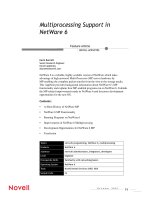Tài liệu Digital Communication in Medical Practice pdf
Bạn đang xem bản rút gọn của tài liệu. Xem và tải ngay bản đầy đủ của tài liệu tại đây (1.25 MB, 178 trang )
For other titles published in this series, go to
www.springer.com/series/1114
Health Informatics
(formerly Computers in Health Care)
Kathryn J. Hannah Marion J. Ball
Series Editors
Nancy B. Finn • William F. Bria
Digital Communication
in Medical Practice
ISBN 978-1-84882-354-9 e-ISBN 978-1-84882-355-6
DOI: 10.1007/978-1-84882-355-6
British Library Cataloguing in Publication Data
Library of Congress Control Number: 2008944093
© Springer-Verlag London Limited 2009
Apart from any fair dealing for the purposes of research or private study, or criticism or review, as
permitted under the Copyright, Designs and Patents Act 1988, this publication may only be repro-
duced, stored or transmitted, in any form or by any means, with the prior permission in writing of the
publishers, or in the case of reprographic reproduction in accordance with the terms of licences issued
by the Copyright Licensing Agency. Enquiries concerning reproduction outside those terms should be
sent to the publishers.
The use of registered names, trademarks, etc. in this publication does not imply, even in the absence of
a specifi c statement, that such names are exempt from the relevant laws and regulations and therefore
free for general use.
Product liability: The publisher can give no guarantee for information about drug dosage and applica-
tion thereof contained in this book. In every individual case the respective user must check its accuracy
by consulting other pharmaceutical literature.
Printed on acid-free paper
Springer London is part of Springer Science + Business Media (www.springer.com)
Nancy B. Finn William F. Bria
Communication Resources Shriners Hospitals for Children
Needham, MA 2900 Rocky Point Drive
USA Tampa, FL
USA
To our children and grandchildren who are the
future: Jeffrey, Glenn, Alex, Marc, David, Ivy,
Gefen and Sydney Finn, Bill and James Bria
Foreword
Enabling the Complexity of Communication in Health Care
The cost, quality, safety, and access problems of healthcare are well known. These
problems are based in and exacerbated by the complexity of healthcare. The knowl-
edge domain of medicine is vast and evolves rapidly. Patients and providers have
an asymmetry of knowledge and experience. Patients with complex acute problems
and multiple chronic disease will be seen by many providers within a short period
of time and will be undergoing several, parallel treatments. The delivery system is
highly fragmented and dominated by small physician groups and hospitals.
Reimbursement mechanisms do not sufficiently reward care coordination and care
that is safe, efficient, and uses the best medical evidence. Managed care contract
provisions can fill volumes.
Over the years we have learned that information technology can be applied to
help address many of the challenges faced by healthcare. We have also learned that
these gains are not an automatic result of application implementation. Systems
design must be thoughtful. Care processes and workflow must be skillfully accom-
modated and changed. Training must be provided on an ongoing basis. Means must
exist for the provider to cover the initial and ongoing costs of the technology.
However, when all of these parallel efforts are carried out, there is a large body of
evidence that care improvement can be significant.
Stepping back from these experiences, one realizes the fundamental contribution
of information technology – it enables complexity. Our financial assets are much
more complex than those of our grandparents; savings accounts have been replaced
by retirement plans and mutual funds that automatically shift assets based on a per-
son’s risk tolerance. Handwritten flight manifests have been replaced by the ability
of an individual to book air travel involving multiple stops and carriers. Weather
forecasting based on seasonal expectations and reports from adjacent states has been
replaced by sophisticated models. Complex activities such as sending a satellite
to Jupiter, noninvasively observing metabolism in the brain and simulating the
interactions between proteins would not be possible without information technology.
vii
viii Foreword
Information technology can be applied to enable the complexity in healthcare.
Clinical decision support and clinical documentation applications can assist the
provider in keeping up with medical evidence. Results management systems can
highlight the patient data that deserves the most attention. Interoperable electronic
health records can support the coordination of multiple providers taking care of an
elderly patient. Telemedicine can assist patients and providers in joint management
of chronic disease.
Decades old methods of paper and telephone are not sufficiently potent to be
effective tools in managing today’s complex healthcare. As a result, the health care
system breaks – repeatedly and with often dire consequences.
Communication is one of the most essential processes in healthcare. It is also
one of the most complex. Communication occurs between many participants –
patients and their provider(s), primary care providers and specialists, professional
societies and practitioners, patients and other patients, and providers and health
insurance companies. The “language” used in the communication is often arcane,
multifaceted, and incomplete. Leveraging information technology to enable the
complex process of communication in healthcare will enable a healthcare system
that not only breaks less often but is more efficient, effective, and safe.
Nancy Finn and Bill Bria have done a superb job of addressing the challenge of
communication in healthcare using information technology. Digital Communication
in Medical Practice provides an insightful, practical, thorough, and highly readable
discussion of the roles that information technology can play in improving the abil-
ity of the physician to communicate with their patients and other providers. The
authors provide a holistic view that integrates a review of the technology with the
necessary parallel activities such as process change and training.
Over the course of the last decade, there has been explosive innovation in com-
munications technologies: the Internet, electronic health record, and personal
health records, the cell phone, electronic mail, remote monitoring technologies. All
of these technologies have witnessed significant increases in their capabilities and
a rapidly maturing understanding of how to apply them. These innovations offer us
new opportunities to improve care.
Information technology can enable us to master the complexity of communica-
tion in healthcare. This mastery will allow us to craft the healthcare delivery system
that our patients and providers deserve. Digital Communication in Medical Practice
moves us significantly toward that goal.
John Glaser, PhD
Vice President and CIO
Partners Healthcare
Series Preface
This series is directed to Healthcare professionals who are leading the transformation
of health care by using information and knowledge. Historically, the series was
launched in 1988 as Computers in Health Care, to offer a broad range of titles:
some addressed to specific professions such as nursing, medicine, and health
administration; others to special areas of practice such as trauma and radiology; still
other books in the series focused on interdisciplinary issues, such as the computer-
based patient record, electronic health records, and networked Healthcare systems.
Renamed Health Informatics in 1998 to reflect the rapid evolution in the discipline
known as health Informatics, the series continued to add titles that contribute to the
evolution of the field. In the series, eminent experts, serving as editors or authors,
offer their accounts of innovations in health Informatics. Increasingly, these
accounts go beyond hardware and software to address the role of information in
influencing the transformation of Healthcare delivery systems around the world.
The series also increasingly focused on the users of the information and systems:
the organizational, behavioral, and societal changes that accompany the diffusion
of information technology in health services environments.
Developments in healthcare delivery are constant; most recently developments
in proteomics and genomics are increasingly becoming relevant to clinical decision
making and emerging standards of care. The data resources emerging from molecu-
lar biology are beyond the capacity of the human brain to integrate and beyond the
scope of paper-based decision trees. Thus, bioinformatics has emerged as a new
field in health informatics to support emerging and ongoing developments in
molecular biology. Translational informatics supports acceleration, from bench to
bedside, i.e., the appropriate use of molecular biology research findings and bioin-
formatics in clinical care of patients.
At the same time, further continual evolution of the field of Health informatics
is reflected in the introduction of concepts at the macro or health systems delivery
level with major national initiatives related to electronic health records (EHR), data
standards, and public health informatics such as the Healthcare Information
Technology Standards Panel (HITSP) in the United States, Canada Health Infoway,
NHS Connecting for Health in the UK.
We have consciously retained the series title Health Informatics as the single
umbrella term that encompasses both the microscopic elements of bioinformatics
ix
x Series Preface
and the macroscopic aspects of large national health information systems. Ongoing
changes to both the micro and macro perspectives on health informatics will continue
to shape health services in the twenty-first century. By making full and creative use
of the technology to tame data and to transform information, health Informatics will
foster the development and use of new knowledge in health care. As coeditors, we
pledge to support our professional colleagues and the series readers as they share
advances in the emerging and exciting field of Health Informatics.
Kathryn J. Hannah
Marion J. Ball
Acknowledgments
We are pleased to acknowledge the assistance of many individuals who contributed
their time, thoughts, and expertise to this book because they believe in health infor-
mation technology as a way to provide safer, better quality healthcare to patients
throughout the world.
We owe a special thanks to Dr. Dan Teres, whose mentoring and insightful
review comments kept this book on track. Several individuals devoted significant
time and effort to help us understand the impact of various health information tech-
nologies and their impact. They include Dr. Joseph Kvedor from the Center for
Connected Health whose invaluable assistance provided us with the appropriate
focus on telemedicine; Dr. Danny Sands, an evangelist and a pioneer in the use of
electronic health records, email, and patient portals; Susanna Fox and the PEW
Institute whose cutting edge research provides invaluable insights in how people
use the Internet; John Glaser who devoted enormous time and effort guiding us
through some of the technical material; Dena Puskin who early on provided con-
nections to key thought leaders in Health IT; Michele Garvin Esq. of Ropes and
Gray LLP who guided us through the difficult legal issues of privacy. We owe a
special thanks to Missy Goldberg who meticulously worked with the authors to
proofread the content and to Tania Helhoski of Bird Design who assisted with
graphics. We thank the editors at Springer Publishing. We recognize the following
healthcare professionals who bought into the idea for this book and provided value
added materials and thoughts:
Tom Abrams, Director Division of Drug Marketing, Advertising, and Communi-
cations (DDMAC), Food and Drug Administration.
Holt Anderson, Executive Director, North Carolina Health Information and Com-
munications Alliance.
John Blair, MD, President & CEO, Taconic IPA.
William Braithwaite, MD, PhD, FACMI Health Information Policy Advisor.
Claire Broome, MD, Director Integrated Health Information Systems, Centers for
Disease Control and Prevention.
xi
xii Acknowledgments
Todd Brown, MHP, RPh, Associate Clinical Specialist and Vice Chair, Department
of Pharmacy Practice School of Pharmacy, Northeastern University.
Gary Christopherson, MD, Senior Advisor; Undersecretary for Health, Veterans
Administration Senior Fellow, Institute of Medicine.
Homer L. Chin, MD, Medical Director, Clinical Information Systems, Kaiser
Permanente.
David Classen, MD, Vice President, First Consulting Group.
Jeffrey Cooper, PhD, Director of Biomedical Engineering, Partners Healthcare,
Boston, MA.
Robert Cox, MD, Director Hays Medical Center, Hays Kansas.
Tom Delbanco, MD, Primary Care Medicine, Beth Israel Deaconess Medical
Center, Boston, MA.
Suzanne Delbanco, PhD, The Leapfrog Group.
Henry DePhillips, MD, Chief Medical Officer, Medem.
George Demetri, MD, Director of Center for Sarcoma and Bone Oncology, Dana
Farber Cancer Institute, Associate Professor of Medicine Harvard Medical School.
Don E. Detmer, MD, MA, President and CEO, American Medical Informatics
Association.
Tom Ferguson, MD, doctortom.com, pioneer in health informatics (deceased).
Ross D. Fletcher, MD, Chief of Staff VA Medical Center, Washington, DC.
Mark Foster, MD, Vice Chairman, Taconic IPA Inc., Chairman, THINC RHIO.
Susannah Fox, Pew Internet & American Life Project.
Charles Ganley, MD, Director, Division of Over-the-Counter Drug Products.
Michele M. Garvin, Esq. Partner, Health Care Group, Ropes & Gray LLP.
John Glaser, Vice President and CIO Partners Healthcare.
JanLori Goldman, Columbia Health Privacy Project.
John Halamka, MD, MS, Chief Information Officer, Caregroup Health System,
Chief Information Officer, Harvard Medical School.
Claus Hamann, MD, MS, FRCP(C), Geriatric Primary Care Massachusetts General
Hospital.
Matthew R. Handley, MD, Family Practice, Group Health Cooperative, Seattle,
WA.
Carol Holquist, RPh, Director, Division of Medication Errors and Technology
Support, FDA, Washington, DC.
Joel Kahn, MD, President, WorldCare Global Health Plan.
Charles M. Kilo, MD, MPH, Greenfield Health, Portland, OR.
Joseph C. Kvedor, MD, Director, Center for Connected Health, Partners Healthcare.
Howard M. Landa, MD, Kaiser Permanente Department of Pediatric Urology.
Acknowledgments xiii
Thomas F. Landholt, MD, Family Practice, Springfield, MO.
David J. Lansky, PhD, Senior Advisor on Health Policy.
Mark Leavitt, MD, PhD, Chairman of the Certification Commission for Healthcare,
Information Technology (CCHIT).
Eric Liederman, MD, MPH, Director of Medical Informatics, Kaiser Permanante
UC Davis, Health Systems.
Steven R. Levisohn, MD, Primary Care, Massachusetts General Hospital, Boston, MA.
Janet Marchibroda, CEO and Founder, eHealth Initiative.
Robert J. Mandel, MD, MBA, eHealth Program, Blue Cross Blue Shield,
Massachusetts.
David Nash, MD, MBA, Professor and Chairman of Health Policy, Thomas
Jefferson University, Jefferson Medical College, Philadelphia, PA.
Larry Nathanson, MD, Director, Emergency Medicine Informatics, Beth Israel
Deaconess Medical Center, Boston, MA.
Marc Overhage, MD, President and CEO of the Indiana Health Information
Exchange.
Dena Puskin, ScD, Director, Federal Office for the Advancement of Telehealth,
U.S. Department of Health and Human Services.
Brian Rosenfeld, MD, Founder VISICU Inc.
Steve Ross, MD, U Colorado Health Science Center, U Colorado Hospital.
Jay H. Sanders, MD, President and CEO of The Global Telemedicine Group,
Professor of Medicine at Johns Hopkins University School of Medicine.
Danny Sands, MD, Assistant Clinical Professor of Medicine at Harvard Medical
School and Senior Medical Informatics Director for Cisco Systems Inc.
Joseph Scherger, MD, MPH, Professor of Clinical Family and Preventive Medicine
at the University of California, San Diego School of Medicine.
Steve Schneider, MD, CMO, Healthwise.
Hasan Sharif, MD, COO, CMO, WorldCare.
Warner Slack, MD, Department of Neurology, Beth Israel Deaconess Medical
Center, Boston, MA, Pioneer Informatics.
Paul Tang, MD, MS, Vice President and Chief Medical Information Officer, Palo
Alto Medical Foundation (PAMF), Stanford, CA.
Lisa Vetter, Telemedicine Specialist, St. Alexius Medical Center, North Dakota.
Jonathan S. Wald, MD, MPH, Associate Director of the Clinical Informatics,
Research and Development (CIRD) Group, Partners Healthcare.
Andy Wiesenthal, MD, Associate Executive Director for Clinical Information
Support, The Permanente Federation.
David Williams Principal, MedPharma Partners LLC.
Contents
Introduction A Visit to the Doctor: Three Scenarios 1
1 eHealth and Patient Safety 7
Medical Error: Woe is Me; Woe is You 8
Keeping Patients Safe 9
The eHealth Triangle 11
The eHealth Professional 11
The eHospital 13
Case Study: The VA has HIT Covered 13
Case Study: The Dana Farber Cancer Institute 14
Case Study: The Dashboard at BIDMC 15
ePatients 16
eHealth Around the World 17
Key Points 19
References and Notes 20
2 New Health Care Models 21
Continuous Available Information on Every Patient 22
EHR in the Hospital Setting 24
Driving the Adoption of the EHR in Small Group and Solo Practices 24
Installation, Implementation, and Impediments to Use 26
EHR Early Adopters Around the World 28
Health Information Exchange and Compatibility 29
Regional Health Information Organizations Information Exchange 30
Case Study: The Indiana Network for Patient Care and Indiana Health
Information Exchange 31
Case Study: The Taconic Health Information Network and Community 32
Computer Physician Order Entry 34
Personal Health Records 35
Case Study: EMC Corporation 38
Key Points 39
References and Notes 40
xv
xvi Contents
3 Communication 43
The Media, the Message, and the Internet 43
The Telephone 44
Smart Phones and PDAs 45
Electronic Mail 46
Portals 50
Case Study: Kaiser Permanente 51
The eVisit 52
Case Study: Medem 54
Case Study: Relay Health 54
Key Points 56
References and Notes 57
4 Telemedicine 59
Why Telemedicine? 59
Telemedicine Technologies and Infrastructure 60
Obstacles 61
Telemonitoring and Home Healthcare 64
Telemedicine for Patients in Remote Areas 66
Case Study: Hayes Medical Center 66
Case Study: St. Alexius Telecare Network of North Dakota 67
Telerehabilitation 68
Speech and Language Therapy 68
Physical Therapy 69
Mental Health Services 69
Telehospice: Death with Dignity 70
Telemedicine around the World 70
The eICU: Remote Monitoring for Intensive Care 70
Key Points 71
References and Notes 72
5 Information Access: Information Overload 75
Healthcare Finds the Internet 75
Information Access 76
Information Overload 77
Resources for Physicians and Patients 80
Institutional Web Sites 84
Professional Organizations 84
Online Resources for Cancer 84
Online Resources for Cardiac and Lung Disease 85
Online Resources for Diabetes and Kidney Disease 85
Online Resources for HIV 86
Online Resources for Ordering Drugs 86
Key Points 89
References and Notes 89
Contents xvii
6 Keeping Health Information Away from Prying Eyes 91
Medical Information is no Longer Private 92
Privacy Issues Concern Physicians and Patients 93
Protecting Data with a Secure Network 94
Malware 95
Automatic Log-off 95
Theft of Removable Media 95
US Federal Regulations Regarding Privacy (HIPAA) 96
The Privacy Rule 97
The European Union on Privacy 97
The Internet 99
Email 101
Case Study: CVS 103
Key Points 104
References and Notes 105
7 Medicating Your Patients 107
Medication Error 107
Electronic Prescribing (E-Prescribing) 108
Case Scenario #1 108
Case Scenario #2 109
Patient Information and Collaborative Drug Therapy 111
Hospital Policies 112
Confusion in the Naming of Drugs 113
Adherence 115
Online Pharmacies 116
Direct-to-Consumer Advertising 118
Resources for Safe Healthcare and Medication Advice 118
Key Points 119
References and Notes 120
8 All About Money 121
How We Measure Healthcare Costs 121
The Underinsured and the Uninsured 123
Controlling Health Expenses with Information Technology 126
Consumer Directed Health Plans (CDHP) 127
Health Reimbursement Accounts (HRA) 128
Health Savings Account (HSA) 128
Pay-for-Performance (P4P) 129
Key Points 130
References and Notes 131
xviii Contents
9 The Quality Quotient 133
A Broken System 134
Why Quality is so Hard to Achieve 135
Health Information Technology 135
Evidence-Based Healthcare Delivery 137
Quality Initiatives Require Change 138
Lessons Learned 140
Resources 140
The EHealth Initiative 141
Bridges to Excellence 141
Cardiac Care Link (CCL) 142
The Leapfrog Group 142
The National Committee for Quality Assurance (NCQA) 142
Joint Commission on Accreditation of Healthcare
Organizations’ (JCAHO) 143
The Agency for Healthcare Research and Quality (AHRQ) 143
The Malcolm Baldrige National Quality Award 144
Centers for Medicare and Medicaid Services (CMS) 145
Key Points 146
References and Notes 147
10 Heathcare 2020 149
A Portrait 149
Devices and Enablers 152
Personal Digital Assistants and Smart Phones 152
Radio Frequency Identification (RFID) 152
Robots 153
Telemedicine 153
Decision Support and Evidenced-Based Medicine 154
Surgery 154
Personalized Medicine 155
Virtual Reality 156
The Practice of Medicine in Healthcare 2020 156
Key Points 158
References and Notes 159
Glossary 161
Index 169
Introduction
A Visit to the Doctor: Three Scenarios
Scenario #1
Dr. Jennifer Hathaway, a primary care physician in a suburb of Chicago starts her
day with 25 files piled on her desk, representing the 25 patients that she will see in
the next eight hours. Her first patient is Eleanor, a healthy 45-year-old woman, who
works as a software engineer. Eleanor is waiting for the doctor in the examining
room after Dr. Smith’s medical assistant has taken her vitals and weight, draws
blood and does an EKG, which she attaches to Eleanor’s chart. Eleanor has also
filled in an update form that has been placed at the front of her chart.
Dr. Hathaway enters the examining room, carrying Eleanor’s file. She gives it a
quick glance noting Eleanor’s weight, blood pressure, and a note about headaches.
She greets Eleanor, shakes her hand and warmly welcomes her back for her annual
visit, observing stress in Eleanor’s face and a slight tremor in the handshake.
Eleanor has been a patient for the past 10 years, and they banter back and forth
about her general health and her family. While examining Eleanor, Dr. Hathaway
asks about any new issues or changes, as she has not had time to read the update
form that Eleanor filled out. When she is finished Dr. Hathaway suggests that
Eleanor get dressed, and meet her in her office.
While she is waiting for Eleanor, Dr. Hathaway quickly reads her update form
and skims through her record, seeking information from the last visit. As they talk
Dr. Hathaway takes copious notes in longhand. She tells Eleanor that her blood
pressure is quite high compared to a year ago and suggests that could be the cause
of her headaches. She recommends that Eleanor start a hypertension medication
and have a stress test. She writes out prescriptions and slips for lab work, which
she hands to Eleanor, reassuring her that there is nothing to worry about.
After the visit, Dr. Hathaway collects and reviews all of Eleanor’s labs and test
results and within a couple of weeks she sends Eleanor a note indicating that her stress
test and other blood work is normal, but her cholesterol is high. She encloses a
prescription for a cholesterol medication and tells Eleanor to call if she has questions.
Unfortunately, the cholesterol medication makes Eleanor dizzy so she calls the office
the next day and leaves a message. Dr. Hathaway calls her back, but Eleanor is not
there. It takes three days and two more rounds of telephone calls before the doctor and
N.B. Finn and W.F. Bria, Digital Communication in Medical Practice, 1
DOI: 10.1007/978-1-84882-355-6_1, © Springer-Verlag London Limited 2009
2 A Visit to the Doctor: Three Scenarios
Eleanor connect. Dr. Hathaway tells Eleanor to immediately stop what she is taking
and indicates that she will call a new drug into the pharmacy. There is no further com-
munication between Dr. Hathaway and Eleanor until her next visit six months later.
Scenario #2
Dr. James Thatcher, who practices general medicine in a community just outside
Atlanta, GA, is proud of the fact that, after much time, expense, and energy, his office
has installed a new computer system with electronic records for all of his patients, a
medications database, and e-prescribing capability. Dr. Thatcher and his staff spent
a weekend in training to help them use and understand the new computer system.
When his patient Dan, a retired 80-year-old contractor with asthma and high
blood pressure, comes in for his six-month visit, he gives his medical card to an
office attendant, who looks up his patient record on the computer and confirms his
identity and birth date. Dan is still asked to fill out a paper update form that he
struggles with as he tries to remember all of the dosages for his medications and
recall his family medical history.
As Dan enters the exam room, Dr. Thatcher is at the computer reviewing his elec-
tronic medical record (EMR). They talk for a few minutes and after examining Dan,
the doctor notes the start of a bronchial infection. While Dan waits, Dr. Thatcher
searches his new medication database to find the right antibiotic to treat Dan’s bron-
chitis. The computer returns with a list of three medications that would be appropriate,
and flags one of the medications that Dan’s health plan will not accept. The doctor
makes his choice and electronically transmits the prescription to Dan’s local phar-
macy where the computer prints a concise set of instructions including a warning on
potential side effects and directions about how Dan should take the drug.
Once again Dr. Thatcher turns his attention to Dan and together they review
Dan’s electronic medical record on the computer and discuss some of the most
recent entries. Dr Thatcher prints a list of web links where Dan can find information
about the new prescription and other medical issues. Dan’s prescription is waiting
when he arrives at the pharmacy on his way home.
Scenario #3
Anne Downes is a primary care physician in Minnesota, who has always been
intrigued with technology and early on adopted an electronic medical record as her
way of keeping patient charts. But Anne is not satisfied with having a static set of
patient records online. She believes in using technology tools for patient communi-
cation and seamless interaction between her prescribing systems, billing systems,
health insurance providers and the hospital where she has admitting privileges.
When Dr. Downes’ patients are scheduled for an office visit, they must do some
of the preparatory work ahead so that she is able to devote 100 percent of her focus
and time to talking, examining, and listening to her patients.
A Visit to the Doctor: Three Scenarios 3
Donna is a 57-year-old teacher with chronic diabetes and arthritis. Donna sees
Dr. Downes every four months. Ten days before her scheduled visit, Donna receives an
email from Dr. Downes with a link to the portal that Dr. Downes shares with her
patients, reminding Donna to go to her private section of the portal and enter her most
recent blood sugar readings from her glucometer. The readings are automatically
graphed by the computer and available for Dr. Downes to review before the visit.
When Donna arrives at Dr. Downe’s office, she goes directly to a computer
terminal where she scans her medical card. This automatically notifies the office
staff and Dr. Downes that she has arrived, and brings up Donna’s electronic health
record. Earlier in the day, an automated computer program sent a checklist of all
the patients scheduled to Dr. Downe’s PDA. From that device she is able to access
Donna’s record and determine the agenda for their visit.
When she arrives, Donna is escorted to an examining room where a nurse takes
her blood pressure, weight, and other vitals and keys the information directly into
Donna’s health record on the computer. She leaves that screen visible for Dr. Downes.
Having already seen Donna’s record and her latest entries on her PDA, Dr. Downes
is able to look very quickly at the computer screen to assess Donna’s condition.
As a result, during the 15 minutes allotted to the visit, Dr. Downes is able to focus
completely on Donna and concentrate on their discussion without the distraction
of having to write notes or look up information. Donna explains that she has been
experiencing pain in her shoulders and tingling down her arms. Dr. Downes recom-
mends that she should see a neurologist who will run some tests. She also prescribes a
new diabetes medication.
At the conclusion of the visit, Dr. Downes takes a few minutes to send a prescription
directly from her computer to the pharmacy; an email to a neurologist with a note
about Donna’s symptoms; and to post links to Donna’s patient portal site. The com-
puter automatically transfers all the information about the prescription, the symptoms,
and the referral to the neurologist to Donna’s electronic health record. Dr. Downes
reminds Donna that if she has any questions she can send her an email. She feels satis-
fied that although her time with her patient is limited, these digital tools provide her
with information and communication that enables a comprehensive, unrushed visit.
As she leaves the office, Donna goes to a kiosk where a computer survey is on
the screen that asks questions about Donna’s satisfaction with the visit. With this
information Dr. Downes is able to make adjustments to the flow of the office visit
to achieve patient satisfaction. When Donna has time, she brings up the portal on
her computer to research the side effects of the new medication, schedule an
appointment with the neurologist and review her lab results.
Communication between doctor and patient that fosters information exchange
and sets up proper expectations plays an important role in developing a trusting
relationship, which correlates to the outcome of care. For centuries, hastily written
notes taken during an office visit have made up a patient’s health record and provided
the basis for a treatment plan. Communication flow from doctor to patient began
with a face-to-face meeting or a telephone conversation when the patient explained
the problem and the doctor listened and then issued orders. There was little oppor-
tunity for discussion, questions, or debate. The fact that a doctor’s decisions did not
include much input from the patient seemed totally appropriate because most
4 A Visit to the Doctor: Three Scenarios
patients believed that their doctors were trained in medical school to make the right
decisions for them.
In spite of the availability of the technology, not much seems to have changed.
Well over two-thirds of doctors’ offices use the same methods for recording and
keeping patients records as they did 50 years ago, which is to say files full of paper
and rooms filled with X-ray film. Most of those same doctors are still communicating
with their patients via telephone and postal service.
Millions of doctor office visits occur every day across the world, and an intricate
patchwork of information from providers and payers is processed for each visit.
The records are on paper or housed in computer systems that typically have limited
ability to exchange data electronically. And because those visits are only one aspect
of healthcare that the individual experiences, the paperwork mounds in isolated
files held by a myriad of medical professionals, including pharmacies, hospitals, labs,
physical and occupational therapists, alternative medicine practitioners, dentists,
specialists of all types, insurance companies, and private databases. These are typically
files that did not communicate with one another.
1
Scenario #1 depicts the traditional office visit that is infused with warmth and
familiarity but lacking in communication between doctor and patient. Much of
Eleanor’s office visit time is spent watching the nurse and the doctor record infor-
mation in her paper chart and ask questions about issues that she had already
supplied on the update form. Facing lots of new problems – high blood pressure,
high cholesterol – Eleanor has questions after her visit with no easy way to have
them addressed. She resorts to an Internet search but is not quite sure about the
reliability of the information she finds.
Scenario #2 depicts an office that has newly adopted communication technology
to supply the doctor with quick answers and reference points. However, this office
is not using these tools to foster better communication between the doctor and his
patient. Dan still has the frustrating task of filling out an update form and trying to
remember all of the important details of his medical history. During his visit, there
are many awkward moments when the doctor is focused on the computer and not
on Dan. Links to information resources are on paper and not the live links that
patients are used to using.
Scenario #3 illustrates how use of communication technology (patient portal,
email, PDA) can improve doctor/patient interaction during the office visit. Marie
does not mind spending a few minutes before her visit updating her record on her
patient portal. It is certainly better than filling in an update form. With the advance
information sent to her PDA and the nurse’s posts to the computer, Dr. Downes is
able to give Donna her complete attention without the distraction of having to take
notes. Email is the frosting on the cake that gives Donna a general sense of being
well cared for, and gives Dr. Downes a sense of providing the best care available.
The twenty-first century healthcare consumer, who is an avid user of the Internet,
email communication, and digital information, realizes that there is more to patient
1
The Markle Foundation and the Robert Wood Johnson Foundation July 2004
A Visit to the Doctor: Three Scenarios 5
care than engaging in a hurried conversation and receiving instructions from a qualified
healthcare professional. With the availability of health information from print media,
television, Internet resources, books, magazine articles, patients have high expecta-
tions that their healthcare experiences will include greater participation, two-way
discussion and a means for follow up if they have questions. Patients want their
experience with a physician to be warm, reassuring, and satisfying. They expect their
doctors to be good listeners and to suggest appropriate information resources that
help them learn more about treatments and options. Patients have a low tolerance for
doctors who allow the telephone to interrupt them, who dismiss their ailments as
incidental, and who avoid confronting difficult situations. They expect their physician
to ask relevant questions and, through eye contact, body language, tempo of speech
and tone of voice, to imply that this discussion has their full, undivided attention.
That means no writing in paper charts and no typing on the computer.
Tommy Thompson U.S. Secretary of Health and Human Services from 2001–
2005 stated during his tenure “grocery stores are more automated than the doctor’s
office.” It is shockingly clear that the healthcare industry has lagged behind every
other institution in deploying simple communication tools, email, cell telephones,
personal digital assistants, text messaging and the Internet, that people use everyday
in their home and work lives.
One of the ways that health information technology can be most effective is in
generating reminders to patients about taking medication on time and all the time,
and providing comprehensive, but understandable information about what a medi-
cation treats and how to properly administer it. Studies have proven that over 50%
of individuals taking medication take their prescribed medications intermittently or
discontinue them altogether. Forgetfulness, confusion about how to take a medica-
tion or why it is necessary, inability to pay for the prescription are all the reasons
cited when patients are asked why they are not adhering to their doctor’s instruc-
tions. Somewhere along the way, there is miscommunication when patients report
that they are unclear about why they are taking a particular medication or why it is
necessary to finish all the medication in the bottle once they are feeling better.
Without a direct channel of communication to the doctor to clear up their confu-
sion, most of the patients’ failure to adhere compounds their problems. The tele-
phone, with its frustrating tag is not an answer. Email with its fast response
mechanism and the ability to provide live links that direct the patient to Websites
that explain a medication and the reasons why it is important or offer comments by
other patients suffering from the same condition can be an effective way to promote
better adherence.
Over 40% of the American population has at least one chronic health condition
(defined as a medical problem that lasts a year or longer, limits what a person can
do, and requires ongoing care). Twenty percent have two or more such conditions
and millions more are officially disabled. An individual practitioner or small group
practice, using paper records, is not well equipped to care for these patients. They
do not have the support staff, time, or tools to work with the patient and the family.
Their medical record system is cumbersome and information is hard to access,
making it difficult to track patients and provide them with the education they need.
6 A Visit to the Doctor: Three Scenarios
The demands of a physician’s daily practice make it difficult to reorganize and train
staff in new communication tools such as electronic health records and patient por-
tals, or to keep up with the latest discoveries, disease threats, and devices designed
to help a physician offer twenty-first century quality medical care. There are no quick
fixes. However, it is incumbent upon healthcare professionals to arm themselves and
their patients with as much information as possible. This can be accomplished with
current technology that enables access to vast information resources.
Digital Communication in Medical Practice is a guidebook that provides a quick
comprehensive overview of the tools available to every practicing physician. The
book illustrates how proven communication technology – the computer, email,
PDAs, and the Internet can help doctors address the crunch of too little time, too
many patients, and too much information. Authors, Nancy Finn, technologist and
Bill Bria, doctor medical informatics expert, and communications expert spent two
years talking with the early adopters, heads of medical institutions, private practi-
tioners, insurers, employers, policymakers, and especially patients. The result is a
book that focuses on how Electronic Health Records (EHR) and Personal Health
Records (PHR) digitize patient information and make it easier for doctors and
patients to collaboratively view and add data to the health record for continuity of
care. This book discusses the convenience of using email and patient portals, to
offer advice about post surgical care, nutrition, changing a medication, or discussing
lab results. It points out how eliminating telephone tag and incorporating email and
Web communications can result in less frequent office visits for those things that can
be handled with a quick response, giving the doctor more time to see patients who
truly have a need to be seen, and enabling the physician to have a more collaborative
relationship with all patients.
Digital Communication in Medical Practice also discusses concerning issues of
security, privacy, and healthcare quality, and outlines the legislative initiatives that
have been passed to protect healthcare information from unauthorized entry. The
book delves into perplexing, but critically important questions about the high cost of
healthcare services and how various payment structures impact the doctor’s ability
to be paid a fair wage for professional services. The authors discuss how the Internet
with its vast information resources quickly and efficiently enables physicians to find
answers that result in better healthcare choices for patients. This book outlines how
practitioners in remote locations can log onto the Internet, and, with simple tools
such as telephones with cameras attached, can consult with super-specialists at
major medical centers. It describes how homebound chronically ill patients can have
their vital signs monitored 24/7 over the Internet. The inclusion of many anecdotal
stories, using fictional names and settings, but based on real patient experiences, and
case studies illustrates how these communication tools or the lack thereof can make
a significant difference in treatment and outcome. A medical professional reading
this book will come to understand that the introduction of digital communication
into a practice including electronic health records, use of the Internet, e-prescribing,
telemedicine, and other technologies will save time, money, and most importantly
will reduce critical medical errors and thus save lives.
Chapter 1
eHealth and Patient Safety
“Change involves the crystallization of new actions, possibilities
new policies, new behaviors, new patterns, new methodologies,
new products or new market ideas, based on reconceptualization
of old ones to make new and hopefully more productive actions
possible.”
Rosabeth Moss Kantor
The Change Masters, Simon and Schuster Touchstone
Division, 1984
John, a Gulf War veteran with cancer, logs into his secure Web-based My HealtheVet
from home and receives updated laboratory results and information about a new
treatment. After reviewing the information John uses the My HealtheVet Web inter-
face to access benefits and eligibility information and to schedule an appointment at
a community-based outpatient clinic close to his home.
Although he does not need them today, John also has access to electronic pre-
scription refills, cancer-specific health information and resources, and record for-
warding eServices for second opinions. He can review and upload clinical
information through a home monitoring unit and can authorize access to My
HealtheVet services for family members.
At a scheduled appointment with his physician, John shares treatment informa-
tion with his doctor and an oncologist from a renowned specialty cancer center
who participates in the discussion via videoconference. Based on a mutual decision
to pursue further treatment, John undergoes several tests to decide if he is an
appropriate candidate.
Once the test results are ready, John is alerted that they have been automatically
added to his electronic medical record and are available for viewing in his personal
health record (PHR). Using his Web interface, he reviews the results at home and
authorizes consent for the cancer center oncologist to make the results available to
a remote care team so treatment planning can begin.
1
Healthcare professionals have spent many years resisting change and holding onto
paper-based clinical record keeping, as well as insisting on face-to-face or telephone
communication with patients. Meanwhile, other industries throughout the world have
embraced computer technology and changed the way they interact with their clients
N.B. Finn and W.F. Bria, Digital Communication in Medical Practice, 7
DOI: 10.1007/978-1-84882-355-6_2, © Springer-Verlag London Limited 2009
8 1 eHealth and Patient Safety
and customers. In the transportation industry, there is no longer any paper. The
eTicket is what you get. When you go to the car dealership to have your automobile
serviced, all of the car’s records are online so the technicians can see exactly what has
been done and what is needed. Banks encourage their customers to access their bank
statements online eliminating the mailed monthly copy. Travel itineraries are planned
online; college courses are delivered via Web-based modules; entertainment tickets
are ordered and delivered online. Even in the retail industry, the landscape is rapidly
changing. When year-end shopping is tallied, more purchases are made online than
traditional face-to-face store encounters.
EHealth programs with electronic storage, retrieval, management and communi-
cation of health information are finally taking hold. As an ePatient, John is proac-
tive and works directly with his doctors to make decisions about his treatment plan.
John’s story illustrates that eHealth fosters a collaborative environment where there
is sharing of information, interactive communication, patient empowerment, and
improved patient safety. It is the patient safety issue that has forced health organiza-
tions to take a closer look at eHealth.
Medical Error: Woe is Me; Woe is You
Jerilyn, a patient at the Beth Israel Deaconess (BID) Medical Center in Boston, had
been seeing an endocrinologist for a benign thyroid tumor. When she revisited the
doctor for a check up, the clinical exam revealed that the tumor had shrunk or
remained the same. Nevertheless, to be safe, the doctor recommended that Jerilyn
get an ultrasound. Jerilyn had the ultrasound, and the next day utilized the BID
patient site, where she was able to review her lab results. What she saw there
shocked her. The radiology report indicated that the tumor had grown from a previ-
ous test. Since this was contrary to the clinical observation, Jerilyn pulled up her
electronic record on her Patient Site. She realized that something did not compute.
When she reviewed both tests she noted that either the radiologist had the wrong
report or had the wrong patient, because the numbers from the earlier test did not
match the numbers from the new test.
Jerilyn called her endocrinologist who was upset that she had seen her labs on
Patient Site before he had a chance to review them. He told her to go into the hos-
pital for a biopsy. Jerilyn called the radiologist who insisted that the report he had
posted was correct. But she still had her doubts so Jerilyn put off the biopsy and
went for an independent ultrasound that confirmed that there was a mistake in the
posting and she did not need a biopsy. Her actions saved her from undergoing a
procedure for no reason and saved the medical system multiple dollars.
Medical errors maim and kill more people per year than breast cancer, AIDS, or
motor vehicle accidents.”
2
“The number of people who die annually in the United States from medical
errors is higher than number of Americans who died in the Korean and Vietnam
wars combined, as reported by official Pentagon sources.”
3
Keeping Patients Safe 9
Although it is true that all human beings including medical professionals make
mistakes, studies conducted by the Institute of Medicine have shown that as many
as 40% of these mistakes are judged preventable!
4
Keeping Patients Safe
Nearly 50% of patients, when asked, say they are concerned about an error result-
ing in injury happening to themselves or to a member of their family when they
receive care as an outpatient or when they go to a hospital for care.
5
Patient safety problems of all types happen. Many are preventable. Some are
inexcusable. All are unwarranted. Typically the errors do not result from individual
recklessness but from flaws in health organizations. One of the most profound
causes of medical error is lack of communication and information. Too often
healthcare professionals are working with incomplete information about a patient
at the point of care.
A study conducted by the Agency for Healthcare Policy and Research (AHCPR)
found that missing clinical information might lead to adverse events and delays in
services in outpatient primary care. AHRQ researchers collected point-of-care data
during patient visits from 253 clinicians across 32 primary care practices on the
type, frequency, and consequences of missing clinical information. Among 1,614
clinical visits, clinicians reported that important information was missing in 13.6%
of cases (220 visits). Among these visits, the most common types of missing infor-
mation were lab and radiology results (45% and 28.2%, respectively), letters or
dictation containing clinical information (39.5%), and patient history or physical
exam findings (26.8%). Clinicians reported that potential adverse outcomes due to
missing clinical information were at least somewhat likely in 44% of these visits,
and clinicians who use electronic medical records were significantly less likely to
report missing clinical information than their peers with paper-based records. They
found that computer systems detected 60 times as many adverse drug reactions in
patients as the traditional method used at one hospital where the study was con-
ducted. These computer-based systems also generate reminders for physicians
related to monitoring and tracking patients, for example, administering flu vaccine
or monitoring and adjusting medications.
6
Missing clinical information can consume physicians’ time and cause undue
worry and grief for the physician and the patient (see Table 1.1 ). Gaps in informa-
tion lead to prescribing medications that do not interact well with other prescriptions
1. Human error caused by illegible writing in medical records or on prescription orders .
2. Failue to integrate clinical information systems .
3. Inaccessibility of records .
4. Lack of information about a patient’s allergies .
Table 1.1 Common Preventable Medical Errors that Occur at the Point of Care









